

1970: A 'Super' season for Funny Car
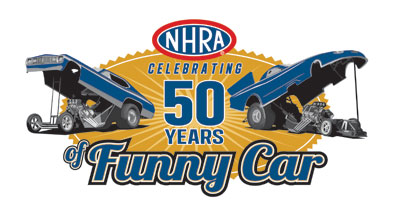
The Funny Car class got its first taste of full integration into the NHRA season in 1970, NHRA’s vaunted “Super Season.” NHRA had nearly doubled its schedule, going from four races to seven – adding the Gatornationals in Gainesville, the Summernationals in York, Pa., and the Supernationals in Ontario, Calif. – and introduced the new Pro Stock class. Super, indeed.
Funny Car ran at all seven races, and even though five different race winners – Larry Reyes, Leonard Hughes, Leroy Goldstein, Don Schumacher, and Gene Snow – were crowned, and even if NHRA still hadn’t been using its tried and true “World Finals winner is the world champion” formula, Snow probably still would have been the champ. Sure, “the Snowman” won the World Finals, but he also won the Summernationals and was runner-up at the Winternationals and Springnationals and posted a statement victory at the postseason Supernationals; only Goldstein and Reyes also made more than one final-round appearance that year – each with a win and runner-up.
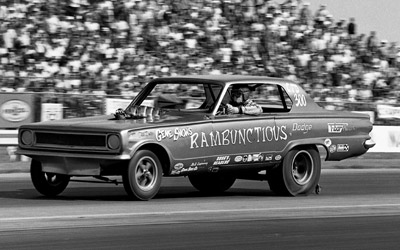
(Above) Gene Snow won Indy back to back in 1966 and 1967 with his Rambunctious Dart, running in the C/Fuel Dragster class. (Below) Snow began experimenting with direct drive in 1968 and piloted this Charger to the class' first 200-mph pass.
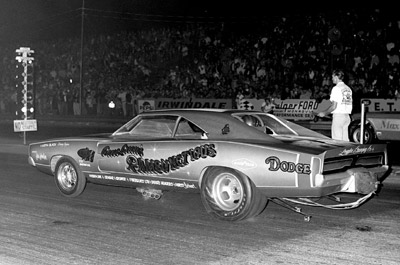
Snow was certainly no stranger to winning in a Funny Car, having driven his pre-Funny Car Rambunctious Dodge Dart “funny car,” built by fellow Texan Don Hardy, to back-to-back national event victories in the C/Fuel Dragster class in Indy in 1966 and 1967, in Comp and Super eliminator, respectively. He also won the Comp title at the 1968 Winternationals with the wild-looking piece, albeit on gasoline in the B/A class. He had a lot of experience with the wild machinery and put it to good use in 1970.
The secret to Snow’s success – which also extended to the AHRA trail, where he also won the season championship and was named Driver of the Year – may well have been the direct-drive setup in his sleek mini Charger. As horsepower began to increase in the class, the standard-use automatic transmissions soon became a weak point, so Snow had begun to experiment with removing the transmission in late 1968 and into 1969. He worked with Crower to come up with a four-disc Crowerglide centrifugal clutch that allowed him to keep the hammer down all the way to the finish line, and his top-end speed soared into the mid-190s.
"Though it was sluggish off the line, it would mow down the automatic cars, which always nosed over at about 185 mph," he told NHRA National Dragster.
Early in 1969, at Don and Carl Gay's track in Dickinson, Texas, not far from today’s Royal Purple Raceway, Snow broke the 200-mph barrier with a pass of 200.88 mph and never looked back. He ran 205.46 mph at Orange County Int'l Raceway and later broke the 210-mph barrier with a 213.78 clocking in September. "I didn't think it was such a big deal at the time, but we kept running more than 200 mph at just about every race after that," he said.
Match race times being considered somewhat unofficial, it took about a year for the first official 200-mph Funny Car pass at an NHRA national event, and, serendipitously, it was Snow who did it, May 3, 1970, with a 208.71 run at Dallas Int'l Motor Speedway during the Springnationals.
Snow’s march to NHRA’s first Funny Car championship began with a runner-up at the 1970 Winternationals behind Reyes, as reflected in last week’s column about the Hawaiian team’s Pomona successes. Snow used a massive holeshot and a 202-mph trap speed to beat Lew Arrington in round one, 7.68 to 7.61, then took a strong 7.40 second-round win when Danny Ongais lost traction in Mickey Thompson’s Mustang. Snow topped 200 again in the semifinals, where his low e.t. of the meet 7.30 outran Kenny Safford’s 7.47 in the Mr. Norm Charger. Reyes, by contrast, was mired in the mid-7.50s at 195 to 196 mph in defeating Rich Siroonian, Kelly Chadwick, and Hughes, the latter two via red-lights, but Snow slipped to a 7.83 in the final and lost to Reyes’ 7.67.

(Above) From left, Paul Candies, Leonard Hughes, Roland Leong, and Larry Reyes all played major parts in the first two races of the 1970 season. (Below) The Gatornationals Funny Car final -- the first "all-team" final in the class' history -- was won by Hughes, far lane, over Reyes.
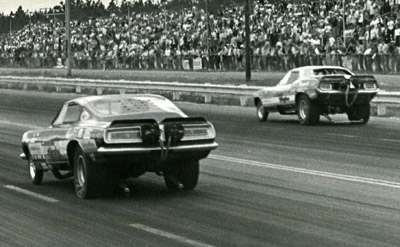
Although the Winternationals had featured a 16-car field, the Funny Car field for the next event on the calendar, the inaugural Gatornationals in Florida just two weeks later, was limited to just eight cars. Maybe NHRA knew something because fewer than 16 entries showed up, and Snow was not among them.
Appropriately for NHRA’s “Super Season,” the field was led by Larry Arnold in the Super Cuda (7.17) and Bobby Rowe in the Super Duster (7.18), followed by Reyes in the Roland Leong-tuned No. 2 Candies & Hughes 'Cuda and a field that also included Hughes, former Super Cuda/Super Ford driver “Super Sidney” Foster in his new King Cobra SOHC Mustang, Bobby Wood and his Rebel Country Chevy II, Phil Castronovo and the Custom Body Enterprises Charger, and Huston Platt in Tommy Smith’s Super Swinger Dart on the bump at 7.33. Chadwick, Connie Kalitta, Ronnie Hunter, Della Woods, and Mel Perry, who lost the roof of the Super Hugger Camaro in a blower explosion during qualifying, were among the alternates.
As history (and last week’s column) tells us, the final boiled down to a battle of temporary teammates, Hughes and Reyes – the first all-team Funny Car final in NHRA national event history -- with Hughes taking the predetermined win. Reyes waited until his light was good and green and Hughes was long gone downtrack before launching, as you can observe in the seldom-seen photo above right. As it was, Reyes still had to lift early, slowing to just 191 mph, to avoid catching Hughes.
On a historically interesting note, on June 1, it became mandatory for all Funny Cars to be equipped with a Freon-based onboard-fire-extinguisher system. Many teams had already been using the systems, but they became a must-have prior to the next event on the calendar, the NHRA Springnationals at Dallas Int’l Motor Speedway.
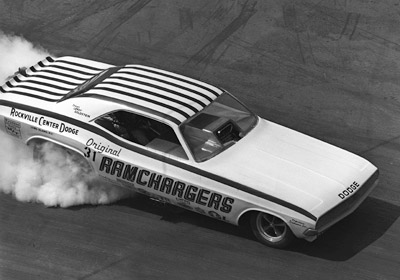
Leroy Goldstein and the Ramchargers: first into the sixes
Four months after the Gatornationals, Snow was back in action in his native Texas as the Funny Car class closed in on the six-second zone. Safford led the 16-car field in the Gary Dyer-tuned Mr. Norm’s Charger with a sizzling 7.04, the quickest official pass in class history, supplanting the 7.10 that Reyes had run in Gainesville. Goldstein, who had moved over from the Ramchargers Top Fueler to its new Challenger Funny Car at the start of the season, was No. 2 with a 7.10 and Snow a distant third at 7.22. Behind them were Hughes, Schumacher and his Barracuda, Rowe, Jake Johnston in the Blue Max Mustang, Tom McEwen in the Hot Wheels Duster, Ray Alley in his new Engine Masters Duster, Bernie Williams in Vance Hunt’s Hemi Hoss Mustang, Texas favorite Don Gay, John Dekker, Don Prudhomme’s Hot Wheels ‘Cuda, Dave Beebe and the Dodge Fever Challenger, Mike Snively in “Diamond Jim” Annin’s Challenger, and, on the bump spot, some guy named Kenny Bernstein in Alley’s Cougar. (All of the cars in the field were powered by either early- or late-model Chryslers, including the Mustangs of Johnston and Williams, Gay’s Pontiac, and Bernstein’s Mercury.)
After Safford’s mighty mount bowed out to handling problems against Alley in round one, Goldstein and Snow became the favorites and reached the final round on the strength of respective 7.07 and 7.09 semifinal elapsed times against Hughes and Prudhomme, and many thought that a six-second run might well be in the offing in the final. Goldstein came close, clocking a 7.03 – the quickest time ever in national competition – at 208 mph after Snow had to shut off after losing traction.
Just 16 days later, June 30, on a Tuesday evening at New York National Speedway, Goldstein and the Ramchargers got that first six with a 6.95 blast and proved it was no fluke a few weeks later with a 6.99 on their home turf at Detroit Dragway. (The history-making car was lost to fire not long after, but its follow-up proved equally adept with a 6.92 blast, the first NHRA national event six, in Indy a few months later.)
The inaugural Summernationals, July 17-19, was held at York U.S. 30 Dragway in York, Pa. – the event would move to its longtime home in Englishtown the following year – and Snow finally reached the NHRA winner’s circle. Snow paced the field (scheduled for 16 cars, but only nine showed up) by a whopping two-tenths, his 7.23 far ahead of No. 2 Tom Sneden’s 7.43 in the Bob Banning Dodge entry. Vic Brown, in Gary Richards’ Chrysler-powered Black Shadow Mustang, was third, followed by Castronovo, local hero Bruce Larson and his USA-1 Camaro (winner of the track’s famed Super Stock Nationals the previous year), Arnold and the Super Cuda, Bob Lani in the Swensen & Lani Barracuda, Jim Maybeck’s new screaming Eagle Camaro, and Ken Poffenberger and his homebuilt Poff’s Super Puffer Corvair. After the all-Chrysler-powered Springnationals, it was good to see three Chevy-motivated entries (those of Larson, Maybeck, and Poffenberger) at York.
After a first-round 7.34 bye for the odd-numbered field, Snow beat Larson with a 7.32, then ripped their throats out with a 7.20 at a booming 214 mph to defeat Castronovo. Brown had worked his way past Lani and a red-lighting Arnold to get the semifinal bye, but his 7.39 best paled alongside Snow’s semifinal ripper. The final round went as expected, with Snow powering to a 7.27 at 210 mph to outdistance Brown’s 7.47.

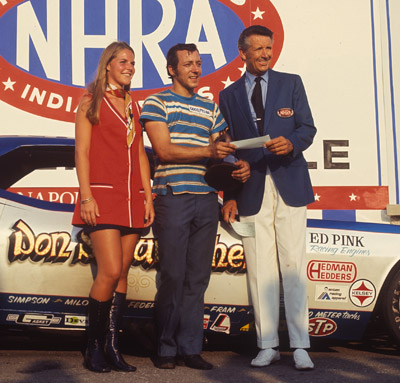
Schumacher, already a terror on the AHRA trail, scored his first NHRA national event win on the sport’s biggest stage, the U.S. Nationals, but it was a hard-fought battle. Just a little more than two months after Goldstein had recorded the sport’s first six-second Funny Car pass, five drivers qualified in the sixes in Indy, led by Hughes’ stunning 6.80 at 214.79 (low e.t. and top speed) in the C&H 'Cuda, which was now sporting one of the new B&M Clutchflite transmissions (an automatic transmission mated to a clutch). He was joined in the sub-seven-second club by Goldstein (6.88, after the aforementioned 6.92 first “official” six-second NHRA pass), Arnie Behling in John Mazmanian’s Barracuda (6.89), Snow (6.94), and Jay Howell in Prudhomme’s Hot Wheels 'Cuda (6.99, right after doing a fire burnout, no less!).
Schumacher, who had run his first six (a 6.93) just a week or so earlier at Orange County Int’l Raceway, was No. 9 at 7.07, setting him up for a gut-check first-round race with Hughes.
Schumacher responded like a champion, slapping a holeshot on the Louisiana leviathan and lighting the win lamp, 7.17 to 7.10. Schumacher stepped up to runs of 7.07 and 7.01 to trailer Howell and future Schumacher team driver Rowe but figured to be in deep in the final against Goldstein, who had set low e.t. of eliminations in round two at 6.83 against Pat Foster, the new driver of Leong’s Hawaiian, and who had run 6.85 in round one.
Schumacher improved again in the final, running 7.00, and his consistency won the day as Goldstein’s Ramchargers mount lost traction, and even a brilliant pedal job and a 7.14 couldn’t catch “the Shoe.”
(Worth noting is that Funny Car low e.t. of the 1969 Nationals was 7.22, meaning an improvement of more than four-tenths in one season; by comparison, low e.t. in Top Fuel was 6.43 by Prudhomme and the Wynn’s Winder slingshot, the same e.t. as set by the late John Mulligan the previous year. No wonder the funnies were dropping jaws everywhere. Although six-second runs were now all the rage at national events, back then, you could not set a national record at a national event, so the Funny Car record did not dip into the sixes until a few weeks after Indy, when Beebe ran 6.99 at the year’s final Division 7 event at Orange County Int’l Raceway.)
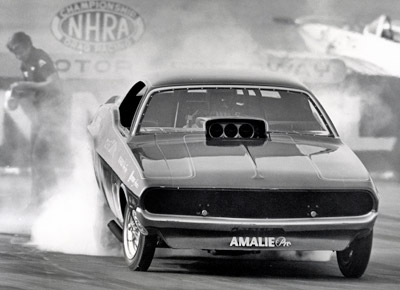
Snow suffered his only first-round loss of his championship season in Indy, falling to Wood’s unexpected 7.07 in what was clearly the upset of the event – not that it really mattered. Even though the World Finals (also held at DIMS) was a winner-take-all deal, division champions earned automatic qualifying berths, and Snow was locked in as the Division 4 champ, having finished well ahead of his former crewmember/future team driver, Johnston. Snow had won just once on the divisional trail, at Oklahoma City Raceway, and Johnston had won at Amarillo Dragway, but even though Snow only reached the one final – Johnston had also been runner-up at Southland Dragway in Houma, La. -- Snow was a consistent late-round finisher everywhere he went and won the divisional title handily.
In addition to automatically seeded division champs, the first five drivers in each class in each division who had earned 500 points during the season were invited to attend the event, but they had to qualify based on e.t.
For some reason, NHRA chose to remove the then-standard 1 percent national record backup rule for the World Finals, and the division champs, with their spots in the field already assured, all took aim at Beebe’s 6.99 record. Snow, who had run an astounding 217 mph at OCIR’s Eastern Funny Car Championships event just weeks before, came closest, running 7.00, which earned him the No. 1 qualifying spot. (It’s also worth noting that during Sunday morning’s allotted time trial, prior to the traditional pre-race parade of qualifiers, Division 7 champ Snively ran 6.97, but it did not count toward qualifying.)
Johnston was right behind Snow in qualifying with a 7.02, and then there was a huge gap to Division 5 champ John Dekker (7.254) and his former partner, Art Ward (7.256); Ward was the champion of the “Travelers” division for drivers whose geographical location favored running in multiple divisions. In the No. 5 spot at 7.26 was Ed McCulloch and partner Art Whipple, with their brand-new Barracuda, a quick replacement after losing their previous car in a towing accident a few weeks earlier.
Snow worked his way past red-lighting Gay with an early-shutoff 7.14 in round one but slipped to a 7.21 in beating Platt in round two, signs that his engine was not happy.
Although Johnston had already exited courtesy of a broken transmission in round one against Brown, two new threats emerged on Snow’s horizon. Snively had impressed with a 7.01 in round one, but it was McCulloch who dropped jaws with a stunning blast of 6.86 at 214.79 mph in round two against Brown. What had been expected to be a cakewalk for Snow had suddenly become anything but.
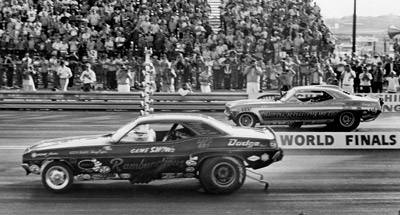
Snow was fortunate to win the World Finals, overcoming breakage and an extremely tough Ed McCulloch in the final to win the world championship.
Snow’s engine finally gave up the ghost in the semifinals against Snively, death smoke from two burned pistons clouding the finish line after a 7.51, 145-mph effort, but Snively had already given the race away on a red-light start that invalidated his 7.02. McCulloch joined Snow in the final with a strong 6.94.
For a while, it looked as if McCulloch might get a bye run to what would have been his first win (and the championship that sadly eluded him the rest of his Hall of Fame career). The Pro Stockers of Ronnie Sox and “Akron Arlen” Vanke had already completed their final-round burnouts before Snow’s car finally pulled into the staging lanes. At the green, Snow got the drop on “the Ace” and raced to a fine but beatable 7.03, his best pass of the day. McCulloch’s mount refused to make the 1-2 shift, but “the Ace” bravely kept his foot to the floor and made a sensational 7.18 pass in low gear, winding the engine to dangerous extremes. Who knows what it would have run if he had been able to grab high gear.
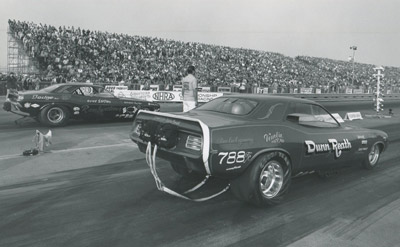
Brand-new Ontario Motor Speedway hosted the inaugural Supernationals, where Snow again was triumphant. Snow, far lane, beat Jim Dunn's new Barracuda in the semifinals with a 6.97 after earlier setting low e.t. with a 6.95.
Even though the championship was locked up in Dallas, Snow added a victory at the non-points, postseason inaugural Supernationals at Ontario Motor Speedway for good measure. Snow qualified No. 4 with a 7.08, behind Prudhomme (7.044), Dunn (7.045), and Foster (7.05); the new Ontario surface had not quite come into its own yet, and top drivers like Goldstein, Jim Liberman, McEwen, and many others failed to qualify.
Snow beat Dekker, red-lighting Hughes, and Dunn before squaring off in the final with Arnold. Both drivers had damaged their engines in the semifinals – Snow had burned three pistons and both cylinder heads, and Arnold’s Kingfish had spun three bearings and hurt the transmission -- and neither was ready when the call was made for their final, so the Top Fuel final between Rick Ramsey and Gerry Glenn was pushed ahead of them on the schedule. When Snow and Arnold were finally ready, neither engine sounded particularly healthy, but Snow chugged it out for the win, 7.49 to Arnold’s blower-belt-tossing 8.68, to end his great season on a winning, if not altogether glorious, note.
“Drag racing completes best season in history,” trumpeted the headline in National Dragster as the fabled “Super Season” came to its conclusion. As far as the Funny Car class in general – and Snow in particular – were concerned, it was an amazing success, and there was no doubt that the “plastic fantastics” were here to stay.



















































